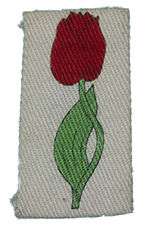204th Independent Infantry Brigade (Home)
| 204th Independent Infantry Brigade (Home) | |
|---|---|
|
Insignia of the Lincolnshire County Division | |
| Active | 12 October 1940-1 September 1942 |
| Country |
|
| Branch |
|
| Type | Infantry Brigade |
| Role | Home Defence |
204th Independent Infantry Brigade (Home) was a Home Defence formation of the British Army during World War II.
Origin
204th Independent Infantry Brigade (Home) was formed for service in the United Kingdom on 12 October 1940 by No 4 Infantry Training Group in the West Midland Area of Home Forces.[1] It was commanded by Brigadier G. McI. Bruce and comprised four newly raised infantry battalions from the North and Midlands of England.[1]
Composition
The composition of 204th Bde was as follows:[1]
- 7th Battalion, South Lancashire Regiment
- 8th Battalion, South Lancashire Regiment (until 31 May 1941)
- 12th Battalion, Sherwood Foresters
- 6th Battalion, King's Shropshire Light Infantry (until 24 November 1941) – converted into 181st Field Regiment, Royal Artillery[2][3]
- 7th Battalion, Leicestershire Regiment (from 205th Independent Infantry Brigade (Home) 26 November 1941)[4]
- 204 Independent Infantry Brigade Company Royal Army Service Corps (joined 31 March 1942)
Service
The brigade moved from West Midlands Area to the Lincolnshire County Division when that was formed on 27 March 1941.[1][5] Lincolnshire County Division ceased to function on 24 November and the brigade (now redesignated 204th Independent Infantry Brigade) was transferred to the Durham and North Riding Coastal Area.[1][5] On 1 September 1942, 204th Independent Infantry Brigade was redesignated 185th Infantry Brigade and its units transferred to other formations.[1][6] 7th South Lancashires, 12th Foresters and 7th Leicesters went to India[7] while 8th South Lancashires was disbanded.[8]
Insignia
The brigade's cloth shoulder badge was a triangle composed of three smaller conjoined triangles in the Facing colours of its three senior units: buff (S. Lancashires), pearl grey (Leicesters) and Lincoln green (Foresters), the whole being edged in blue (KSLI).[9]
Notes
References
- Lt-Col H.F. Joslen, Orders of Battle, United Kingdom and Colonial Formations and Units in the Second World War, 1939–1945, London: HM Stationery Office, 1960/Uckfield: Naval & Military, 2003, ISBN 1843424746.
- Don Neal, Guns and Bugles: The Story of the 6th Bn KSLI – 181st Field Regiment RA 1940–1946, Studley: Brewin, 2001, ISBN 1-85858-192-3.
